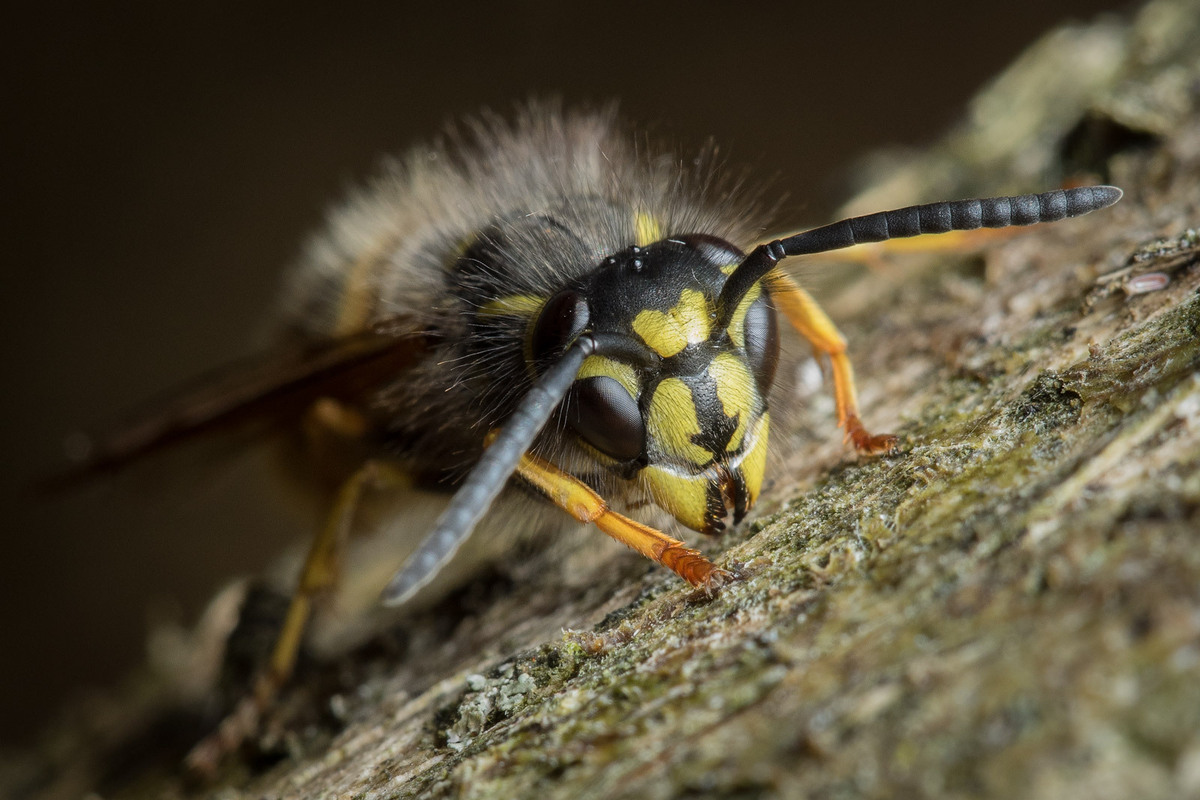Home>Gardening News and Trends>Latest News>What Biological Characteristics Have Contributed To The Success Of Insects


Latest News
What Biological Characteristics Have Contributed To The Success Of Insects
Modified: January 22, 2024
Discover the latest news on the biological characteristics that have driven the remarkable success of insects. Explore their adaptations and evolutionary strategies in this informative article.
(Many of the links in this article redirect to a specific reviewed product. Your purchase of these products through affiliate links helps to generate commission for Chicagolandgardening.com, at no extra cost. Learn more)
Table of Contents
Introduction
Insects are the most dominant and successful group of organisms on the planet. With over a million described species, they represent more than half of all known living organisms. What makes insects so remarkable is their ability to adapt and thrive in almost every habitat on Earth, from the depths of the ocean to the highest mountaintops.
The evolutionary success of insects can be attributed to a combination of biological characteristics, which have enabled them to survive and outcompete other organisms throughout millions of years of evolution. From their adaptations for flight to their efficient respiratory systems, insects have developed an array of features that have contributed to their unparalleled success.
This article explores the various biological characteristics that have played a significant role in the success of insects. We will delve into their adaptations for flight, small size and high reproduction rate, exoskeleton and cuticle, metamorphosis, versatile feeding habits, efficient respiratory systems, social behavior and communication, and their ability to exploit various habitats. By understanding the unique attributes of insects, we gain insight into why they have become such a dominant and diverse group in the natural world.
Evolutionary Success of Insects
Insects have achieved remarkable evolutionary success, dominating the planet for millions of years. This success can be attributed to several key factors.
Firstly, insects have incredibly diverse and adaptable body plans. They exhibit a wide range of anatomical features, allowing them to occupy diverse ecological niches and exploit various resources. This adaptability has given insects a competitive edge over other organisms and contributed to their ability to thrive in virtually every ecosystem.
Another crucial factor is their reproductive capacity. Insects have high reproductive rates, with many species capable of producing large numbers of offspring within a short period. This rapid reproduction allows them to compensate for high mortality rates and overcome environmental challenges. Additionally, the ability to undergo multiple generations in a single year further accelerates their population growth, enabling them to quickly adapt to changing environmental conditions.
Furthermore, insects possess efficient and diverse feeding strategies. They have evolved to be herbivores, carnivores, scavengers, or even parasites, depending on their ecological niche. This versatility in feeding habits allows them to exploit a wide range of food sources, ensuring their survival in different environments.
Insects also benefit from their small size. Their miniature stature provides advantages such as efficient resource utilization, enhanced mobility, and reduced resource competition. The ability to occupy small and narrow spaces enables them to access abundant but inaccessible resources, giving them a competitive advantage over larger organisms.
Additionally, the exoskeleton of insects is a key evolutionary adaptation that has contributed to their success. The exoskeleton, composed of chitin and proteins, provides protection against predators, mechanical support, and resistance to desiccation. This external skeletal structure has allowed insects to exploit a wide range of habitats and withstand various environmental conditions.
Overall, the evolutionary success of insects can be attributed to their adaptability, high reproductive capacity, diverse feeding strategies, small size, and protective exoskeleton. These characteristics have enabled them to occupy ecological niches, reproduce rapidly, and exploit diverse resources, solidifying their status as the most successful group of organisms on Earth.
Adaptations for Flight
One of the key factors contributing to the success of insects is their remarkable adaptations for flight. The ability to fly has provided insects with a significant advantage in terms of dispersal, foraging, mating, and avoiding predators.
Insects have evolved specialized flight structures, including wings and lightweight bodies, that allow them to navigate through the air with agility and efficiency. Their wings are typically made of a thin membrane stretched over a network of veins, providing both strength and flexibility.
Flight muscles in insects are attached directly to the wings, enabling rapid and precise movements. These muscles contract and relax quickly, allowing insects to maneuver in tight spaces, change direction swiftly, and hover in mid-air. The ability to fly has facilitated the colonization of new habitats, the discovery of new food sources, and the establishment of successful breeding populations.
The adaptations for flight also extend to the respiratory system of insects. As insects actively engage in flight, they require a continuous supply of oxygen to fuel their high metabolic rates. To meet this demand, they have developed a highly efficient respiratory system consisting of a network of tiny tubes called tracheae. These tracheae deliver oxygen directly to the cells, ensuring a constant supply of oxygen during flight.
Furthermore, insects have evolved sensory structures that aid in flight navigation. They possess compound eyes, which consist of multiple individual lenses, providing a wide field of vision. This visual system allows insects to detect obstacles, locate food sources, and find suitable mates while in flight. In addition to their compound eyes, many insects also have specialized structures called halteres, which provide information about body position and aid in maintaining balance during flight.
Overall, the adaptations for flight in insects have played a crucial role in their success. Flight has enabled insect species to disperse to new areas, find abundant resources, and avoid competition and predators. The ability to navigate through the air with precision, coupled with efficient respiratory systems and specialized sensory structures, has elevated insects to new heights of evolutionary success.
Small Size and High Reproduction Rate
Two key attributes that have contributed to the success of insects are their small size and high reproduction rate. These characteristics have allowed insects to rapidly adapt and proliferate in diverse environments.
The small size of insects provides them with several advantages. Firstly, their miniature stature allows them to occupy niches and habitats that are inaccessible to larger organisms. They can exploit tiny crevices, burrow into soil, or hide among vegetation, maximizing their access to resources and reducing competition.
Additionally, the small size of insects translates into efficient resource utilization. They require relatively fewer resources, such as food and energy, compared to larger organisms. This efficiency allows them to survive in environments where resources are limited or fluctuating, giving them a competitive edge.
Furthermore, the small size of insects enhances their mobility. They can move quickly and effortlessly through their environment, facilitating foraging, mating, and escaping from predators. Their ability to navigate through narrow spaces and utilize flight as a means of transportation allows them to explore and exploit a wide range of habitats.
Another contributing factor to the success of insects is their high reproduction rate. Many insect species can produce a large number of offspring within a short period. This rapid reproduction compensates for high mortality rates and increases the chances of survival for the species.
Insects employ various reproductive strategies to ensure the survival of their offspring. Some species engage in mass mating events, where numerous individuals gather to maximize breeding opportunities. Others employ reproductive tactics such as laying eggs in large numbers or utilizing specialized reproductive structures.
The high reproduction rate of insects is further enhanced by their ability to undergo multiple generations in a single year. With short generation times, rapid development, and the capability to reproduce throughout the year, insects can adapt quickly to changing environmental conditions and take advantage of favorable circumstances.
The combination of small size and high reproduction rate has contributed to the incredible diversity and abundance of insects. These characteristics allow them to colonize and thrive in various habitats, rapidly adapt to new challenges, and maintain population stability even in the face of environmental fluctuations.
Exoskeleton and Cuticle
The exoskeleton is a vital adaptation that has contributed to the success of insects. Composed of a tough outer layer called the cuticle, the exoskeleton serves as a protective shield, providing structural support, defense against predators, and resistance to desiccation.
The rigid exoskeleton of insects is made up of a combination of chitin, proteins, and other complex substances. This external skeletal structure provides insects with a level of protection that internal skeletons cannot offer. It acts as a barrier, shielding their soft internal tissues from physical injury and providing a shield against predators.
Additionally, the exoskeleton plays a crucial role in maintaining the shape and structure of an insect’s body. It provides attachment sites for muscles, giving insects the ability to generate powerful and precise movements. This structural rigidity allows insects to scuttle through narrow crevices, burrow into soil, and navigate complex environments with ease.
Furthermore, the exoskeleton helps insects conserve water and prevent desiccation. The cuticle acts as a waterproof layer, preventing excessive moisture loss and maintaining the insect’s internal water balance. This adaptation allows insects to thrive in arid environments where water is scarce or fluctuating.
The exoskeleton is not a static structure; it can molt and regenerate. Through the process of molting, insects shed their old exoskeleton, replacing it with a larger and more mature one. Molting allows insects to grow, adapt to changing environmental conditions, and repair any damage or wear and tear suffered by the exoskeleton.
The cuticle, the outermost layer of the exoskeleton, can also possess specialized structures and features that provide additional benefits to insects. For example, some cuticles may have microscopic protrusions or waxy coatings that enhance their water-resistant properties or reduce friction during movement.
The exoskeleton and cuticle have contributed significantly to the success of insects. The protection and support provided by the exoskeleton, coupled with its ability to conserve water and molt for growth and repair, have allowed insects to conquer various habitats and survive in challenging conditions.
Metamorphosis
Metamorphosis is a remarkable and unique biological process in insects that has played a significant role in their success. It involves a distinct series of developmental stages, each with its own morphology and behavior, allowing insects to adapt to different ecological niches and overcome resource limitations.
There are two main types of metamorphosis observed in insects: incomplete metamorphosis and complete metamorphosis. In incomplete metamorphosis, the insect undergoes three stages: egg, nymph, and adult. The nymphs resemble miniature versions of the adult and gradually develop into mature individuals. This type of metamorphosis is commonly seen in insects such as grasshoppers, cockroaches, and true bugs.
Complete metamorphosis, on the other hand, involves four distinct stages: egg, larva, pupa, and adult. The larval stage, often characterized by a worm-like appearance, is specialized for feeding and growth. After a period of development, the larva enters the pupal stage, during which it undergoes profound changes in body structure and behavior, often appearing dormant. Eventually, the adult insect emerges from the pupal case and undergoes its final transformation. This type of metamorphosis is observed in insects such as butterflies, beetles, and flies.
Metamorphosis provides several advantages to insects. Firstly, it allows for differentiation of ecological roles between the larval and adult stages. The larval stage can focus on feeding and growth, while the adult stage is optimized for reproduction and dispersal. This division of labor enables insects to exploit different resources and occupy distinct niches, maximizing their chances of survival.
Furthermore, metamorphosis reduces competition for resources between different developmental stages. By having distinct body forms and ecological requirements at each stage, there is less competition for food and shelter within a species. This enables efficient resource utilization and reduces the risk of resource depletion.
Metamorphosis also facilitates dispersal and colonization of new habitats. The dormant pupal stage allows insects to be transported over long distances by wind, water, or other mechanisms, increasing their chances of reaching new areas with abundant resources and fewer competitors.
Lastly, metamorphosis contributes to the overall genetic diversity of insect populations. The drastic changes that occur during metamorphosis provide opportunities for genetic recombination and adaptation. This variability enhances the ability of insects to respond to environmental changes and increases their chances of survival in evolving ecosystems.
Overall, metamorphosis is a remarkable adaptation that has enabled insects to occupy diverse ecological niches, reduce competition, facilitate dispersal, and enhance genetic diversity. The ability of insects to undergo this transformative process has undoubtedly contributed to their incredible success and proliferation as a group.
Versatile Feeding Habits
Insects exhibit an astonishing range of feeding habits, which has contributed to their remarkable success and ability to thrive in various environments. Their versatile feeding strategies allow them to exploit a wide array of food sources, making them highly adaptable to different ecological niches.
One common feeding habit among insects is herbivory, where they consume plant material as their primary food source. While some insects consume specific parts of plants, such as leaves or roots, others have evolved to feed on a wide range of plant species. The ability to digest and utilize plant matter has allowed insects to inhabit diverse ecosystems, from lush rainforests to arid deserts.
Additionally, insects have evolved carnivorous feeding habits, consuming other insects or small animals as their main source of nutrition. Predatory insects have specialized mouthparts, such as mandibles or piercing-sucking mouthparts, to capture and feed on their prey. This predatory behavior enables them to regulate certain pest populations and maintain natural ecological balances in various habitats.
Scavenging is another feeding habit observed in certain insect species. These insects feed on decaying organic matter, such as dead animals, fallen fruit, or decomposing plant material. Their ability to efficiently decompose organic matter contributes to ecosystem nutrient cycling and recycling, playing a vital role in maintaining ecosystem health.
Parasitism is yet another feeding habit that has evolved in some insect species. Parasitic insects, such as fleas, ticks, and lice, feed on the blood or tissues of host organisms. This feeding strategy allows them to survive and reproduce at the expense of their hosts. Parasitic insects have evolved specialized adaptations, such as piercing mouthparts or attachment structures, to extract nutrients from their hosts.
Insects also exhibit a range of specialized feeding habits, such as nectar-feeding or pollen-feeding. These insects play a crucial role in plant pollination, transferring pollen from one flower to another and facilitating plant reproduction. The mutualistic relationship between insects and flowering plants has been essential for the diversification and success of both groups.
Furthermore, some insect species have developed unique feeding habits through their symbiotic relationships with other organisms. For example, ants farm aphids and feed on the sugary secretions they produce, while the aphids benefit from the ant’s protection. These complex interactions highlight the adaptability and flexibility of insects in finding novel food sources.
The versatile feeding habits of insects have allowed them to exploit a wide range of ecological niches and food resources. The ability to feed on different types of plants, other insects, organic matter, or even through parasitism has provided insects with the capability to survive and proliferate in various environments. This adaptability in feeding has undoubtedly contributed to their tremendous success and abundant presence on Earth.
Efficient Respiratory System
Insects possess a highly efficient respiratory system that plays a crucial role in their remarkable success. This specialized system allows insects to obtain the oxygen they need for survival and maintain high metabolic rates, enabling them to thrive in diverse habitats.
The respiratory system of insects primarily consists of a network of tiny tubes called tracheae. These tubes extend throughout the insect’s body, delivering oxygen directly to the tissues and removing carbon dioxide, the waste product of respiration. The tracheae branch out, forming smaller tubes called tracheoles, which penetrate the cells, ensuring oxygen reaches every part of the insect’s body.
Unlike mammals, insects do not possess lungs or a circulatory system dedicated solely to gas exchange. Instead, the tracheal system allows for a direct exchange of gases between the environment and the body tissues. This direct delivery of oxygen to the cells allows insects to have a high respiratory surface area relative to body size, facilitating efficient gas exchange.
Insects are able to maximize oxygen uptake by actively pumping air through their tracheal system. They accomplish this by a rhythmic contraction and relaxation of their body muscles, which compresses and expands the tracheal tubes, facilitating gas movement. Some species further enhance their respiratory efficiency through specific adaptations, such as specialized air sacs or spiracles that can be opened and closed to regulate gas exchange.
The efficient respiratory system of insects not only enables them to meet their oxygen demands but also provides several advantages. Firstly, the direct delivery of oxygen to tissues allows for rapid oxygen uptake, enabling insects to sustain their high metabolic rates. This is vital for activities such as flight, which demands a significant amount of energy.
Furthermore, the absence of a respiratory pigment, such as hemoglobin in mammals, allows for additional physiological advantages. Insects are not limited by the capacity or availability of a respiratory pigment, allowing them to adapt to low oxygen environments or periods of oxygen deprivation more effectively. This flexibility in oxygen transport enhances their ability to survive in challenging conditions.
The efficient respiratory system also enables insects to occupy diverse habitats, including those with low oxygen levels, such as high altitudes or water bodies. Some aquatic insects have evolved specialized adaptations, such as plastrons or gills, that allow them to extract oxygen from water or create air supplies beneath the water’s surface.
Overall, the efficient respiratory system of insects, with its direct delivery of oxygen to tissues and efficient gas exchange, has contributed significantly to their success. It allows insects to sustain high metabolic rates, engage in energetically demanding activities, and inhabit various environments, making them one of the most adaptable and successful groups of organisms on the planet.
Social Behavior and Communication
Social behavior and communication have played a crucial role in the success of certain insect groups. Many insects exhibit complex social structures and possess sophisticated methods of communication, which have allowed them to form organized colonies and efficiently coordinate their activities.
One of the most well-known examples of social behavior in insects is seen in ants, bees, and wasps. These insects live in highly organized colonies with a division of labor among individuals. They have specialized castes, such as queens, workers, and soldiers, each with specific roles and responsibilities. This division of labor enables efficient functioning of the colony, with individuals performing tasks ranging from foraging and nest building to defense and reproduction.
Communication is critical for social insects to coordinate their activities and maintain colony integrity. They employ a variety of communication methods, including chemical signals, tactile cues, and visual displays. Chemical signals, in the form of pheromones, play a vital role in social insect communication, conveying information about food sources, alarm signals, or mate attraction. Tactile communication involves physical contact between individuals, allowing for the transfer of information or stimulation of specific behaviors.
Besides social insects, other insect species also exhibit forms of communication. For example, male fireflies communicate with females through the emission of light signals, creating a synchronized and mesmerizing display. Male crickets produce distinctive chirping sounds to attract mates, with different species having unique patterns and frequencies of chirping. These communication strategies enable individuals to locate suitable mates and ensure successful reproduction.
Antennae, the sensory appendages found on the heads of insects, play a crucial role in communication. They are highly sensitive and equipped with sensory receptors that allow insects to detect chemical signals, vibrations, and air movements. Through antennal interactions, insects can convey information about food sources, recognize nestmates, or signal aggression or submission.
The evolution of social behavior and sophisticated communication in insects has provided them with several advantages. Living in colonies allows insects to share resources, pool defensive efforts against predators, and deal with challenges collectively. Cooperation within a social group enhances their chances of survival and reproductive success.
Communication also enables efficient foraging and nestmate recognition, reducing conflicts and ensuring the smooth functioning of the colony. The ability to transmit information about food availability or potential threats allows individuals to respond quickly and adapt to changing environmental conditions.
Overall, social behavior and communication have been pivotal in the success of insects. The ability to form complex social structures, coordinate activities, and communicate effectively has allowed them to thrive in a variety of ecological niches, adapt to diverse challenges, and maximize their chances of survival and reproductive success.
Ability to Exploit Various Habitats
One of the key factors contributing to the success of insects is their remarkable ability to exploit various habitats. Insects have colonized virtually every habitat on Earth, from rainforests to deserts, freshwater environments to polar regions. This adaptability has allowed them to thrive and diversify, making them the most dominant group of organisms on the planet.
The ability of insects to exploit different habitats stems from their physiological and behavioral adaptations. Firstly, insects have a diverse range of feeding habits, allowing them to exploit a wide array of food sources. This versatility in diet allows insects to inhabit different ecosystems and survive on available resources, whether it be plants, other insects, decaying matter, or even blood.
In addition to their feeding habits, insects have evolved a remarkable range of unique adaptations that enable them to survive in specific habitats. For example, many insect species have adaptations to thrive in arid environments, such as the ability to conserve water or tolerate extreme temperatures. Some insects have specialized structures, like plastrons or hydrofuge hairs, that allow them to survive in aquatic habitats by trapping air bubbles or repelling water.
Furthermore, the small size of insects provides them with the advantage of accessing and exploiting a wide range of microhabitats within larger ecosystems. They can occupy small crevices, burrow into soil, or find shelter in vegetation. These microhabitats often provide insects with unique resources and protection from predators, reinforcing their ability to adapt and thrive in diverse environments.
The reproductive strategies of insects also contribute to their ability to exploit various habitats. Their high reproductive rates and the production of numerous offspring increase the chances of colonization and adaptation to new environments. The ability to disperse rapidly, whether through migration, flight, or other mechanisms, allows insects to reach and colonize distant and unexplored habitats.
Furthermore, the incredible evolutionary plasticity of insects allows them to rapidly adapt to changing environmental conditions. They can undergo genetic and phenotypic changes over short periods, facilitating their survival in dynamic habitats. This adaptability is reflected in their ability to adjust behavior, physiology, and life history traits to make the most of the available resources in a specific habitat.
Overall, the ability of insects to exploit various habitats has been instrumental in their success. Their diverse feeding habits, unique adaptations, small size, reproductive strategies, and adaptability allow them to colonize and thrive in virtually every corner of the world. By occupying and adapting to a wide range of habitats, insects have established themselves as the most diverse and abundant group of organisms on Earth.
Conclusion
The success of insects can be attributed to a combination of remarkable biological characteristics that have allowed them to thrive and dominate various habitats on Earth. From their adaptations for flight and small size to their high reproduction rates and efficient respiratory systems, insects have developed a suite of features that contribute to their unparalleled success in the natural world.
The evolutionary adaptations of insects, such as their ability to fly, have provided them with an advantage in dispersing to new areas, discovering food sources, and finding suitable mates. The efficient respiratory system of insects, coupled with their ability to actively pump air through their tracheal networks, allows for rapid oxygen uptake and supports their high metabolic rates. Additionally, the small size of insects enables them to exploit diverse microhabitats, efficiently utilize resources, and access otherwise inaccessible areas.
The exoskeleton and cuticle of insects provide them with protection, structural support, and resistance to desiccation, enabling them to inhabit a wide range of environments. Metamorphosis, a unique and complex process in insects, allows for differentiation of ecological roles, reduced competition, and enhanced genetic diversity.
Insects also exhibit versatile feeding habits, ranging from herbivory, carnivory, scavenging, parasitism, to specialized feeding strategies such as nectar-feeding or pollen-feeding. This adaptability allows them to exploit a wide range of food sources and occupy diverse ecological niches.
Moreover, social behaviors and communication in certain insect groups, such as ants, bees, and wasps, enable them to form organized colonies, divide labor, and efficiently coordinate activities. The ability to communicate through chemical signals, tactile cues, and visual displays enhances their cooperation and increases their chances of survival and reproductive success.
An additional factor contributing to the success of insects is their tremendous ability to exploit various habitats. Their adaptability, reproductive capacity, versatile feeding habits, and ability to rapidly respond to changing environmental conditions have allowed them to colonize virtually every corner of the planet.
In conclusion, the combination of these biological characteristics has contributed to the unparalleled success and diversity of insects. Their ability to adapt, reproduce rapidly, communicate, and exploit diverse habitats has solidified their position as the most dominant and successful group of organisms on Earth.








